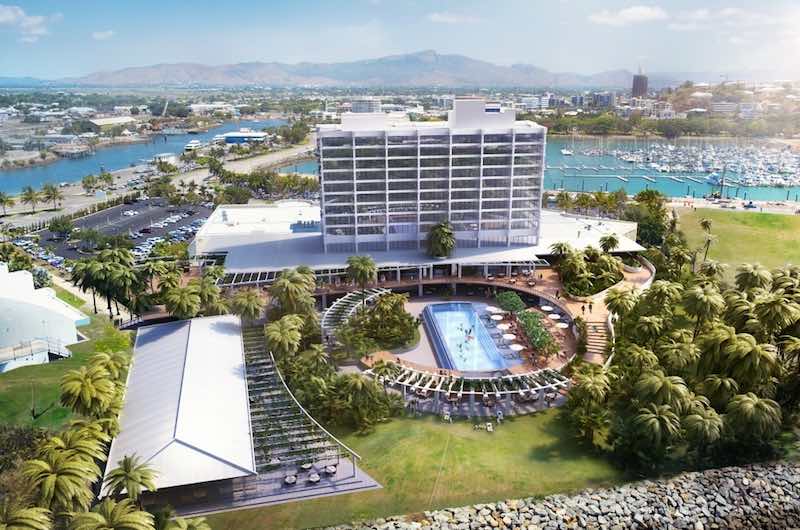
A luxury resort in Townsville in Queensland’s north is looking to cut its grid power consumption by up to 70 per cent, through a suite of cutting edge renewable energy and energy efficiency upgrades.
The major overhaul at the Ville Resort-Casino, owned by Morris Group, is being led by Australian integrated energy solutions provider, nu-tility, and will feature a 2.25MW solar car shade.
That structure, alone, is expected to cut the facility’s grid power consumption by around one-third.
But nu-tility director and co-founder Daniel Barber, says that beyond the solar carport was a much broader job that needed to be done, using a wide range of technologies and management systems.
“We had to take into account the legacy buildings – some of which are around 30 years old – and a massive new ($40 million) re-development that is plugging in to that 30-year old asset,” including a new swimming pool and new restaurants.
“So we carried out a number of energy audits across the site, and then we sat down with the board and went through the energy audit plan.”
All up, Barber tells One Step, nu-tility presented the board – including Morris Group’s Hayley Morris – with three lists of things that could be done: a ‘red flag’ list of absolute musts; a list of optional energy and water saving projects; and a final list of aspirational, “over and above” measures.
In short, it was a massive job, but using a range of solutions and an innovative finance model (the costs of the project are commercial in confidence), that job is largely getting done.
And, of course, it helps that the owners of the Ville are committed to running sustainable businesses.
“The Morris Group is absolutely passionate about these things,” Barber said.
Indeed, the company’s tourism assets include the Orpheus Island Resort – an off-grid operation that is currently being weaned from diesel power to 80 per cent solar and storage – and the Daintree Eco Lodge & Spa; both which are projects that nu-tility is also managing.
But as well as being environmentally minded, the company – headed up by Chris Morris, a BRW Rich List-er who is perhaps best known for founding Computershare – has a keen eye on the bottom line.
“The CFO would not allow anything to happen if it did not make sense,” Barber says.
“Every single item (on our lists) is transparent… and most of it stacks up very well (financially). There’s just that little bit of cream on the top” – such as electric vehicles and a planned reverse osmosis water desalination plant – “that make it more expensive… and might require a small amount of finance from outside sources to make it viable.”
So what exactly is being done at the Ville – with its 194 rooms, four to five food and beverage outlets, swimming pool, four to five conference areas, and gaming floor – to cut its grid electricity consumption by such a large amount?
As well as the 2.25MW solar carport, nu-tility will be tapping co-gen technology, solar hot water heat pumps, and waste to heat technology – to provide heat for the common hot water system and steam for the laundry irons.
On top of those tech solutions, nu-tility will work with Tangible Technologies (a Morris Group offshoot) to develop a bespoke building management system (BMS), to maximise the efficiency of its lighting, heating, ventilation and cooling systems.
“The HVAC system (at the resort) is responsible for well over 40 per cent of the site’s energy usage,” Barber says.
The team will also work to make the site’s three existing large chillers more efficient, as well as the hotel’s fan-cooling system – where the air-con is run 24/7, even when rooms are unoccupied, largely to combat the north Queensland humidity.
“We have put e-metering and chilled water metering on every room,” Barber says, and added anti-microbial treatments to the cooling systems.
And of course the company will also be working to bring the lighting at the site – between 6000 and 7000 units in total – “under control.”
As for the “cream on top,” Barber says nu-tility is working up “an ambitious but realistic e-transport plan,” which could include buying some electric mini-buses for transporting staff, and some patrons, between Morris Group sites.
Through this strategy, he says, the goal is to displace about 30,000 fossil fuel car journeys a year.
Another more aspirational goal for the Ville is to install a reverse-osmosis desalination plant, in a bid to reduce the site’s water usage by 30 per cent – “to start.”
Another target is to cut the business’s waste to landfill in half – partly by using the waste to energy technology, and partly through better processes and recycling.
But the job won’t finish when the technology is installed and the strategies implemented.
Barber says that nu-tility has committed to stay with the site to ensure the continuation of maximum energy efficiency, specialist knowledge, and to continue to integrate new technologies.
The kitchens, for instance, which run on gas, have room for improvement in future, and the couple of gen-sets currently used for back up power at the resort could be replaced with battery storage.
“We have to smart about it… we want to be pioneers in sustainability,” Barber says. “That’s where the world is going.”
This article was originally published on RenewEconomy’s sister site, One Step Off The Grid, which focuses on customer experience with distributed generation. To sign up to One Step’s free weekly newsletter, please click here.







